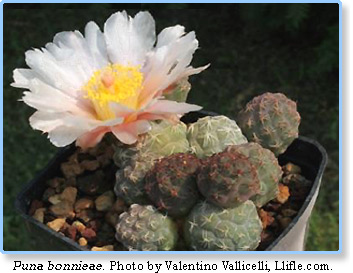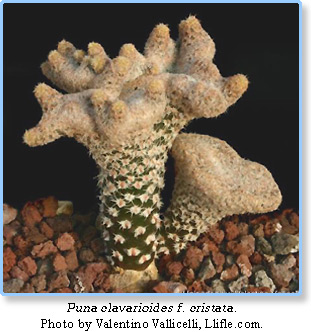Puna (2018)
By Nikki Murdick (July 2018)
 Historically, it is said that the genus Puna was created by Roberto Kiesling in 1982 to encompass just two plants, which earlier had been known as Opuntia subterranea, named in 1905, and O. clavarioides (1837). The reason for his combining these plants into their own genus was to group plants with similar morphological characteristics – growth habits and taproots.
Historically, it is said that the genus Puna was created by Roberto Kiesling in 1982 to encompass just two plants, which earlier had been known as Opuntia subterranea, named in 1905, and O. clavarioides (1837). The reason for his combining these plants into their own genus was to group plants with similar morphological characteristics – growth habits and taproots.
Then, in 1997, a new plant was discovered, described and included with the previous two. This plant was known as Puna bonnieae. Since that time, more detailed studies of seed structure and DNA indicated these plants are more appropriately placed in the family Opuntioideae.
These three plants have had numerous names and been considered in the Opuntia, Tephrocactus, Cumulopuntia and Maihueniopsis genera, as well as Puna, so you may find these plants labeled with any of those names. In addition, the three Puna plants now have been expanded to include three additional subspecies: P. bonnieae cv. Inermis, P. clavarioides f. cristata and P. subterranea f. incahausi.
All of these plants come from high-altitude areas, usually growing at about 3,000 meters above sea level in Argentina or Bolivia. They typically grow hidden in grass or shrubs, or among rocks. During the winter, their long taproots pull them down into the soil. If you grow these plants, they need a deep pot with well-draining soil. As with other high-altitude cacti, they need a lot of light, as well as a cool, dry winter rest period.
If you like small cacti that are slow-growing, have beautiful flowers and don’t take up much room in your collection, these are the plants for you. After you consider each of the six forms described below, you will probably want to collect them all.
 Puna bonnieae
Puna bonnieae
![]() Puna bonnieae or Maihuinopsis bonnieae, now based on recent research to be called Tephrocactus bonnieae, is endemic to Argentina and found in a very restricted range at about 3,000 meters altitude. This small geophytic plant is difficult to find during the dry season, when it shrinks into the soil for most of the year. It is considered endangered because of its very restricted range, which has been devastated by collectors.
Puna bonnieae or Maihuinopsis bonnieae, now based on recent research to be called Tephrocactus bonnieae, is endemic to Argentina and found in a very restricted range at about 3,000 meters altitude. This small geophytic plant is difficult to find during the dry season, when it shrinks into the soil for most of the year. It is considered endangered because of its very restricted range, which has been devastated by collectors.
Puna bonnieae f. inermis
![]() Puna bonnieae f. inermis or Maihueniopsis bonnieae cv. Inermis comes from a small area in the province of Catamarca in Argentina at about 3,000 meters above sea level. In cultivation, it is often spineless, while in the wild, it typically has very short, flat spines; the spineless version is very rare. Both types of Puna bonnieae have a fat taproot, so growing them in cultivation requires deep pots and a well-draining potting mix. They tolerate light frost, but need to rest in a cool place during the winter period. Without this rest period, they do not bloom as well.
Puna bonnieae f. inermis or Maihueniopsis bonnieae cv. Inermis comes from a small area in the province of Catamarca in Argentina at about 3,000 meters above sea level. In cultivation, it is often spineless, while in the wild, it typically has very short, flat spines; the spineless version is very rare. Both types of Puna bonnieae have a fat taproot, so growing them in cultivation requires deep pots and a well-draining potting mix. They tolerate light frost, but need to rest in a cool place during the winter period. Without this rest period, they do not bloom as well.
Puna clavarioides
![]() Puna clavarioides or Maihuenopsis clavaroides comes from Argentina at an altitude of approximately 3,000 meters. Listed as the type species for the genus Puna, it is a low-growing geophytic cactus with subterranean stems arising from large roots. It grows hidden among rocks, where it mimics them, or is scattered under shrubs and in grasses, so it is difficult to find. It also can be found in extremely barren areas where other vegetation does not survive. Although it is abundant where it is found, it is considered threatened because of mining and tourism in those areas.
Puna clavarioides or Maihuenopsis clavaroides comes from Argentina at an altitude of approximately 3,000 meters. Listed as the type species for the genus Puna, it is a low-growing geophytic cactus with subterranean stems arising from large roots. It grows hidden among rocks, where it mimics them, or is scattered under shrubs and in grasses, so it is difficult to find. It also can be found in extremely barren areas where other vegetation does not survive. Although it is abundant where it is found, it is considered threatened because of mining and tourism in those areas.
 Puna clavarioides f. cristata
Puna clavarioides f. cristata
Puna clavarioides f. cristata or Maihuenopsis clavarioides f. cristata is a version with distinctive mushroomlike, conical stems. It also can have cristate, fan-shaped forms or branching fingerlike stems. A single plant can have all three forms, although in the wild, only the tops of the stems can be seen.
This plant is sometimes called Crested Dead Man’s Fingers or the Crested Mushroom Opuntia. It is also a mountain cactus from Argentina, and like the other forms of this cactus, has a fat, elongated taproot. All the punas tolerate light frost, but require a cool winter rest in order to flower and even survive in cultivation.
Puna subterranea
Puna subterranea or Maihuenopsis subterranea is also found in Argentina as well as Bolivia. It is a single-headed plant with a deep taproot, as its name indicates. In cultivation, it may clump, although it is very slow-growing.
Puna subterranea f. incahuasi
Puna subterranea f. incahuasi or Maihuenopsis subterranea subs. pulcherrima is a subspecies that was discovered in 2000 near Incahuasi in Bolivia. It was originally described as Tephrocactus pulcherrimus, then as Cumulopuntia subterranean subsp. pulcherrima. Currently, there are questions as to whether it is a viable subspecies. This plant is also a slow grower, but does tend to proliferate more than the type species in both habitat and culture.
Selected Sources
The Cactus Family – Edward Anderson, 2001
The European Garden Flora Flowering Plants: A Manual for the Identification of Plants Cultivated in Europe, Both Out-of-Doors and Under Glass – Editors: James Cullen, Sabina G. Knees, H. Suzanne Cubey, 2011
The New Cactus Lexicon – David Hunt, 2006
Encyclopedia of Cacti – http://www.llifle.com/Encyclopedia/CACTI/Family/Cactaceae/15895/Puna_subterranea_f._incahuasi
CactiGuide.com – http://www.cactiguide.com/cactus/?uname2=Puna subterranea
IUCN Red List of Threatened Species – http://www.iucnredlist.org/details/40822/0
